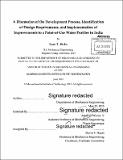| dc.contributor.advisor | Amos G. Winter, V. | en_US |
| dc.contributor.author | Ricks, Sean T | en_US |
| dc.contributor.other | Massachusetts Institute of Technology. Department of Mechanical Engineering. | en_US |
| dc.coverage.spatial | a-ii--- | en_US |
| dc.date.accessioned | 2015-12-03T20:53:16Z | |
| dc.date.available | 2015-12-03T20:53:16Z | |
| dc.date.copyright | 2015 | en_US |
| dc.date.issued | 2015 | en_US |
| dc.identifier.uri | http://hdl.handle.net/1721.1/100097 | |
| dc.description | Thesis: S.M., Massachusetts Institute of Technology, Department of Mechanical Engineering, 2015. | en_US |
| dc.description | Cataloged from PDF version of thesis. | en_US |
| dc.description | Includes bibliographical references (pages 81-83). | en_US |
| dc.description.abstract | Over 780 million people worldwide do not have access to clean drinking water. In India, one product that attempts to address this issue is the Tata Swach, a home purifier which makes water biologically safe to drink by neutralizing bacteria and viruses using silver nanoparticles. This thesis presents research which focuses on improving adoption of this life-saving technology. A holistic approach is followed which takes into consideration the product's technical performance as well as socioeconomic factors that may influence user acceptance. A mathematical model of flow through the purifier is developed and a design tool based on this model is created to allow the optimization of flow rate while maintaining purification efficacy. The development process used to design the Swach is analyzed and compared to literature to determine how this may have affected the product's ultimate success. The importance of incorporating the voice of the customer is emphasized. To that end, surveys among current Swach users are conducted and the responses are applied to Fishbein's Multi-Attribute Attitude Model to determine which design parameters are most important to the customer. "Quality of filtered water" and "ease of maintenance" are identified as the factors that most affect a user's overall satisfaction with the product. A technical issue that may affect these parameters - non-uniform flow through the purifier's porous medium - is identified and experimentally confirmed. Finally a design change to minimize the effects of non-uniform flow in the porous medium is suggested. | en_US |
| dc.description.statementofresponsibility | by Sean T. Ricks. | en_US |
| dc.format.extent | 83 pages | en_US |
| dc.language.iso | eng | en_US |
| dc.publisher | Massachusetts Institute of Technology | en_US |
| dc.rights | M.I.T. theses are protected by copyright. They may be viewed from this source for any purpose, but reproduction or distribution in any format is prohibited without written permission. See provided URL for inquiries about permission. | en_US |
| dc.rights.uri | http://dspace.mit.edu/handle/1721.1/7582 | en_US |
| dc.subject | Mechanical Engineering. | en_US |
| dc.title | A Discussion of the Development Process, Identification of Design Requirements, and Implementation of Improvements to a Point-of-Use Water Purifier in India | en_US |
| dc.type | Thesis | en_US |
| dc.description.degree | S.M. | en_US |
| dc.contributor.department | Massachusetts Institute of Technology. Department of Mechanical Engineering | |
| dc.identifier.oclc | 929073674 | en_US |
